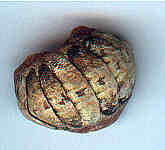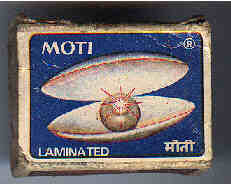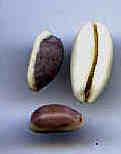Your path =Home>Beadmaking & Materials>Organic Materials> Beads and Seashells
Beads and Sea Shells
A shell is the hard, outer covering, in this case animals collectively called molluscs (mollusks). Molluscs are soft creatures that make the second largest group (or phylum) of animals on earth, outnumbered in their variety only by the insects. Although we commonly speak of "sea shells," molluscs are very successful and live in fresh water and on land as well as in the sea. They occupy most niches on Earth, except that none of them fly.
|
There are five major groups (classes) of molluscs. Two are of no interest to shell bead collectors. One of these is the chitons, with their segmented shells. The other is the group of large molluscs that include the octopus and squid. Octopuses have no shells but the most advanced mollusc. An octopus is said to be as intelligent as a house cat.
Cuttlefish, a squid-like animal, have an internal structure of shell-like material called cuttlebones. They are hung in bird cages to provide lime and salt for birds. Jewelers also use them as molds because they can be easily carved and take heat well when molten metal is poured into them.
Shells for beads come from one of the other three classes. One of the oldest and most popular are the dentalium or tusk shells. They have been used as beads for thousands of years because they are one of the few objects in nature that are naturally perforated.
They are little curved tubes.
A second class of shells, the bivalves, is called that because they have two parts.
These are the clams, mussels, oysters and scallops. They are sometimes attractive,
but are not used as much for beads as the next group.
It is, however, mostly the bivalves that furnish us with the "ultimate beads," pearls.
The word for "bead" in many languages is simply the word for "pearl."
|
The most important group of seashells for beads is the univalves or gastropods --
the snails, whelks and conchs. Sometimes they are attractive and thin and can be strung up just with a needle, such as umbonium shells. At other times they are usually cut up into smaller pieces to be made into beads, such as abalones
(yes, an abalone is a univalve, not a bivalve).
|
Shells are sometimes strung whole to serve as beads. At other times they are cut up to form raw material for beads. Some are used by extracting only a part of a shell, as is common for cowries, one of the most important bead shells.
The rest of the gallery shows a number of different shells used for beads and discusses some of the fascinating world of shell beads.
__________________________________________________
Small Bead Businesses | Beading & Beadwork | Ancient Beads | Trade Beads
Beadmaking & Materials | Bead Uses | Researching Beads | Beads and People
Center for Bead Research | Book Store | Free Store | Bead Bazaar
Shopping Mall | The Bead Auction | Galleries | People | Events
The Bead Site Home | Chat Line | Contact Us | Site Search Engine | FAQ


